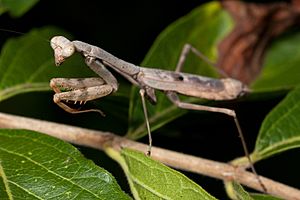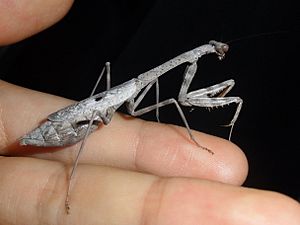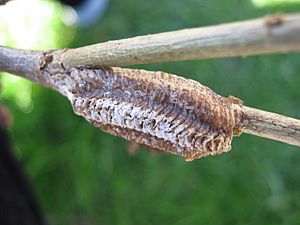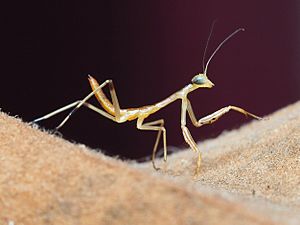Carolina mantis facts for kids
Quick facts for kids Carolina mantis |
|
|---|---|
 |
|
| Adult female Carolina mantis | |
| Scientific classification |
The Carolina mantis (Stagmomantis carolina) is a type of praying mantis. It is known for its amazing hunting skills. These insects are found in many parts of the Americas.
One interesting fact about the Carolina mantis is that they sometimes eat each other. This can happen if they are very hungry or if they meet another mantis.
You might see Carolina mantis egg cases, called oothecae, sold in garden stores. People buy them to help control garden pests naturally. This is called biological control. It's important to make sure you get the right kind of egg case, though. Many sold in the United States are from the Chinese mantis, which is not native here. The Carolina mantis is also the official state insect of South Carolina.
Contents
What does the Carolina Mantis look like?
Adult female Carolina mantises are usually about 47 to 60 millimeters (2 to 2.5 inches) long. Males are a bit smaller, often around 54 millimeters (2.2 inches) long. When they first hatch, baby mantises (called nymphs) are tiny, only about 7 to 12 millimeters long. As they eat more, their bodies grow longer.
Colors and Camouflage
Carolina mantises can be dusty brown, gray, or green. These colors help them blend in with their surroundings, like leaves or bark. This is called camouflage. What's really cool is that young mantises can change their color to match their environment each time they shed their skin. This helps them stay hidden from predators and prey.
Wings and Markings
Adult female Carolina mantises have wings that only cover about three-quarters of their body. This is a special feature. Both male and female Carolina mantises have a dark spot on each of their front wings. Sometimes, this spot can be hard to see if the mantis is a dark brown color.
Where do Carolina Mantises live?
The Stagmomantis carolina is native to the Americas. You can find them from the United States all the way south to Brazil. They live in many different habitats, blending in with their surroundings.
See also
 In Spanish: Stagmomantis carolina para niños
In Spanish: Stagmomantis carolina para niños




